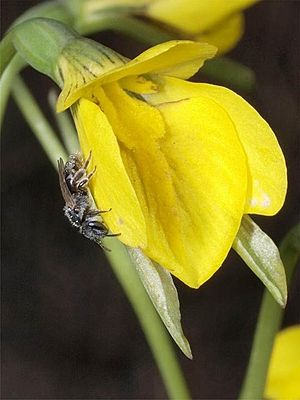Little golden moths facts for kids
Quick facts for kids Little golden moths |
|
|---|---|
 |
|
| Diuris basaltica with the bee Lasioglossum cognatum | |
| Conservation status | |
| Scientific classification | |
| Genus: |
Diuris
|
| Species: |
basaltica
|
The Diuris basaltica, often called the little golden moths or small golden moths, is a special type of orchid. It grows only in Victoria, Australia. This beautiful orchid has faced a huge drop in numbers. This happened because its home was cleared for farms and then for cities. Now, only about 400 of these plants are left in the wild.
Contents
What Does the Little Golden Moths Orchid Look Like?
The little golden moths orchid is a tuberous plant. This means it has a round, underground stem that stores food. It is also a perennial herb, which means it lives for more than two years and has soft, green stems.
These orchids grow about 60 to 150 millimeters (2.4 to 5.9 inches) tall. They have three to seven long, thin green leaves. Each leaf is about 30 to 100 millimeters (1.2 to 3.9 inches) long and 1 to 2 millimeters (0.04 to 0.08 inches) wide.
Flowers of the Little Golden Moths Orchid
The orchid has up to three bright golden yellow to orange-yellow flowers. These flowers are about 15 to 20 millimeters (0.6 to 0.8 inches) wide. They often have a few dark streaks. The flowers usually lean downwards and sometimes do not open fully.
Each flower has different parts:
- The dorsal sepal is the top part of the flower. It stands mostly upright and is about 7 to 12 millimeters (0.28 to 0.47 inches) long and 6 to 8 millimeters (0.24 to 0.31 inches) wide.
- The lateral sepals are two parts that curve downwards. They are about 10 to 16 millimeters (0.39 to 0.63 inches) long and 1.5 to 2.5 millimeters (0.06 to 0.10 inches) wide.
- The petals look like ears. They are egg-shaped, about 6 to 10 millimeters (0.24 to 0.39 inches) long and 3.5 to 6 millimeters (0.14 to 0.24 inches) wide. They have a green stalk about 3 to 4 millimeters (0.12 to 0.16 inches) long.
- The labellum is the special lip-like part of the flower. It has three sections. The two side sections are small and bumpy. The middle section is broadly egg-shaped, about 7 to 10 millimeters (0.28 to 0.39 inches) long and 7 to 11 millimeters (0.28 to 0.43 inches) wide. It has two ridges near its base and a central ridge that goes almost to its tip.
These orchids usually bloom from September to October.
How the Little Golden Moths Orchid Got Its Name
The Diuris basaltica was first officially described in 2006. This was done by a botanist named David Jones. His description was published in a magazine called Australian Orchid Review.
The second part of its scientific name, basaltica, is a Latin word. It refers to the type of soil where this orchid grows. This soil comes from basalt rock.
Where Do Little Golden Moths Orchids Live?
Little golden moths orchids grow alongside kangaroo grass. They are found on the eastern parts of the basalt plain, which is west of Melbourne.
This orchid used to live in many more places across the volcanic plains of south-western Victoria. However, its population has dropped dramatically. This happened first because its natural home was cleared for farming. Later, cities and towns expanded, taking over more of its habitat.
Protecting the Little Golden Moths Orchid
Today, Diuris basaltica only survives in three small groups of plants. The largest group has about 400 plants and is on private land. Only five plants are protected in a special reserve. Another two plants are found in a third group, also on private land.
The biggest dangers to this orchid are:
- Habitat loss: Its home is being destroyed.
- Disturbance or destruction: Plants are being harmed or removed.
- Grazing: Animals eating the plants.
- Weed invasion: Other plants taking over their space.
- Altered fire regimes: Changes in how often or how intensely fires happen, which can affect the orchid's growth cycle.
Because it is so rare, the little golden moths orchid is listed as "endangered". This protection comes under two important laws: Victoria's Flora and Fauna Guarantee Act 1988 and the Australian Government's Environment Protection and Biodiversity Conservation Act 1999. These laws help protect plants and animals that are at risk of disappearing.


